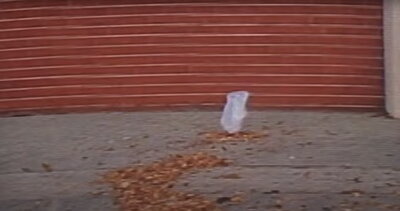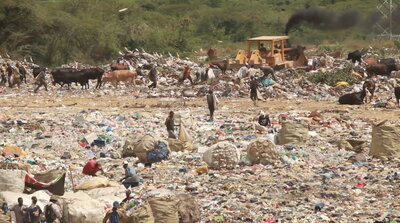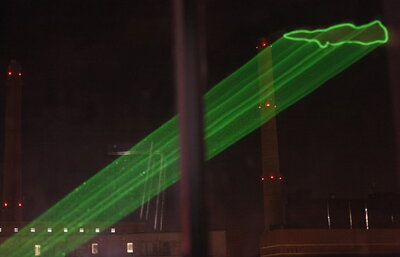On November 1, 2022, Zsuzsa Gille (Sociology, UIUC) delivered the Modern Critical Theory lecture entitled “The Material(ity) Turn” which centered around texts and theories about how humans-nonhuman assemblages form political powers. All images and quotes are from the lecture unless otherwise noted.
Gille began by addressing the inseparability of the material from the social, showing two seemingly contrasting videos of plastic trash. In a scene from the film American Beauty, a plastic bag is portrayed as a vibrant matter, an autonomous subject swaying to and fro in the wind without any human intervention. In contrast, in a scene at a dump site, the piles of plastic trash are seen as passive matter, the afterlife of being used and discarded by humans. The human presence is, though more prominent in the latter, also evident in the former. Gille suggested that looking at the plastic bag as an autonomous matter is not only a romantic, anthropomorphic projection, but also a parochial understanding of the socio-material world. The social is always already present as the plastic bag has been manufactured, used, discarded, found, and filmed.


Gille points out the shortcoming in Jane Bennett’s account of Material Vibrancy; its reliance on examples of thing-power (dead rats, gloves, trash, etc.) are often singular, localized, and micro-level. While Bennett’s novel ontology of matter shifts the perspective away from mechanistic, functionalistic, and static views of materials, towards something more anthropomorphic, the political dimensions of matter can only be deciphered when framed in more globalized, interscale, and dynamic relationships of human-nonhuman assemblages because matter—Gille argues—is a political entity. As an example of the materiality of politics, Gille talks about Robert Moses’s nine-foot overpasses throughout Long Island in the 1920s and 1930s are the intentional implementation of discriminatory infrastructure, as these obstacles physically limited access to the beach to those who were rich enough to own small cars in the early 20th century, excluding larger public transit like buses.

To further illustrate how the power of social-material assemblage comes into being, Gille introduces Bruno Latour’s Actor-Network Theory (ANT), a theoretical and methodological approach to understanding that everything in the social and material worlds is “co-production by humans and nonhumans” forming a constant shifting network of relationships of actants. What ANT reveals is the way “facts are made, accepted, and proven in their usefulness by an extending network of actants.” Once things are drawn inside the network, their capacity to become true increases. Infrastructures, like Moses’s overpasses, are prime examples of “acting at a distance,” a Latourian socio-political mechanism theorized out of Foucauldian distributive, panoptic apparatus. Speed bumps, for instance, not only exert powers on drivers to slow down without the police presence (the police, thus, acting at a distance), but also reinforce its presence, meaning, and efficacy for each encounter simultaneously.
Elaborating on the concept of “acting at a distance,” Gille discusses Chandra Mukerji’s “logistical power” which refers to political dominance in which the subjects of the power become steadily more dependent on the governing body as they rely on an increasingly complex system (i.e. infrastructure). Mukerji’s example of the Canal du Midi in 17th century France, an large-scale infrastructural intervention, illustrates how infrastructure and its complex systems act as a political entity itself (impersonal power) that overrides the more traditional form of power (strategic power) to which the local nobilities had previously been accustomed. The traditional political tools, including “making and breaking alliances using ideology, religions, cajoling, intimidating, coercion, or violence,” could not match the capacity of logistical power which resided not in the ruler himself but in the operation and administration of the government. This logistical power not only increased the tax revenues from the economic activities along the canal but also weakened the administrative authority of local nobilities, which ultimately resulted in the ruler’s expansion of territorial sovereignty without the help of the local nobilities.
To describe how political power gets intertwined with technology, Gille introduces Timothy Mitchell’s concept of Technopolitics, emerged in the 1990s, being defined as a technical “alloy” of both human (intentional) and nonhuman (nonintentional) in which the intentional (humans) is often overrun by the unintended (nonhumans). For example, the malaria breakout in the south of Egypt is an unintended consequence of various human activities. Transportation using ships and trains led to the territorial expansion of gambiae mosquitoes carrying the malignant form of the malaria parasite northward, far beyond its typical two-mile radius. Added to this, infrastructural interventions in damming the Nile created stagnant waters which provided the conditions for the insect’s exponential multiplication. The unintended consequences, in Mitchell’s account, were caused by humans (the intentional and the intellectual) in their attempt to organize nonhumans (the unintentional and the natural). Mitchell, therefore, departs from the Latourian flat ontology of networks of human-and-nonhuman actants, and suggests that humans are accountable for the (unintended) outcomes. Mitchell sees a danger in flattening the agentive powers of different actors, and thus maintains the asymmetrical relationships between humans and nonhumans.
Shifting from the historical to the contemporary, Gille then discussed Noortje Marres’ concept of Material Publics, concerning how technological devices “spark political discourse” in public. Marres finds new, crucial roles and capacities of technological devices to embed certain practices in the social and successively raise political consciousness in public. Traditionally, the public relies on experts in order to become familiar with issues such as environmental damages due to their often invisible and inaccessible natures (i.e. air pollution). However, contemporary technological devices such as carbon meters, and even artistic, commodified interventions such as Nuage Vert, can help humans to visualize the environmental metrics and motivate environmentally sensible behaviors. These practice-based interventions, in Marres’s account, not only generate a more traditional form of political activism and participation in public discourse but also bring otherwise apolitical individuals into the material-practice-based political dimension.

Technological devices are a crucial channel to initiate a bottom-up political activism but can also be a crucial means for official processes such as criminal investigations. Gille entwines the practice aspects of the material public with Material Semiotics, a set of methodological inquiries, rather than ontological, that concern with the way things gain meanings in particular relations with other things. Using Amade M’Charek’s example of the use of CCTV in a criminal investigation, Gille explains how racial profiling comes into being as a result of “being placed in a particular constellation of other things.” Reiterating the Latourian concept of “gaining reality” in a network, race becomes a fact only in relation to other factors such as clothing, bodily movements, locality, prejudices, and conflicts between Christians and Muslims. Material semiotics is a crucial method here because it shows not only how race is a socially constructed concept but also how certain phenotypical characteristics become (false) “reality” or (fictional) “facts” when being intertwined with the networks of human-nonhuman assemblage. The challenge when it comes to studying race, Gille cautions, is to denaturalize the race from a deterministic, biological inquiry, while simultaneously not dematerializing race.
Concluding, Gille noted that “materiality can only be understood in concretely situated action” and warned that Bennett’s “vibrancy” is insufficient to achieve emancipatory politics of things, for it fails to capture the social effects made of humans-nonhuman complex. Although, as exemplified in Marres’s concept of material public, things seem vibrant, activating the political reactions of the public, Gille departs from Bennett in calling for a focus on practice.